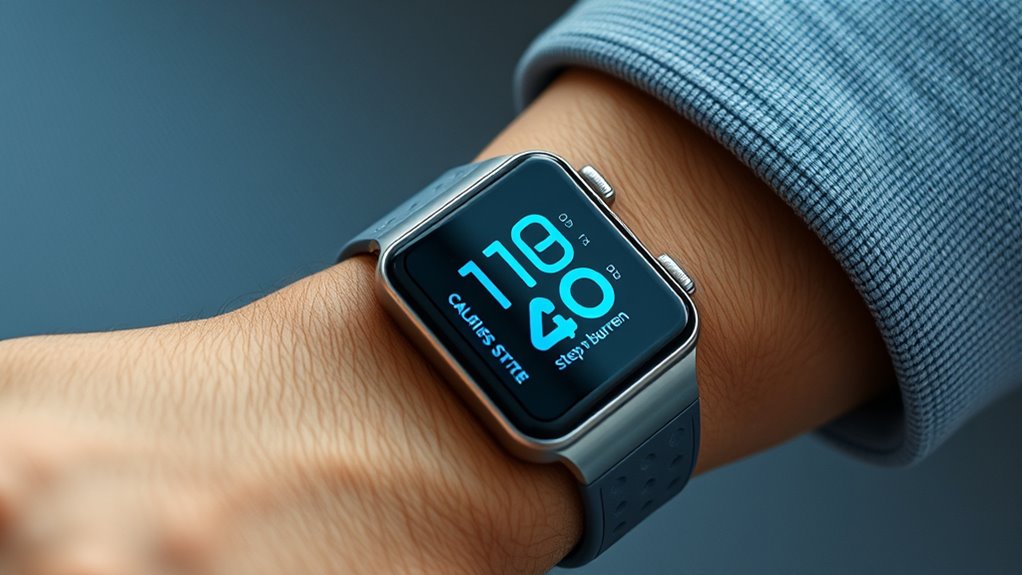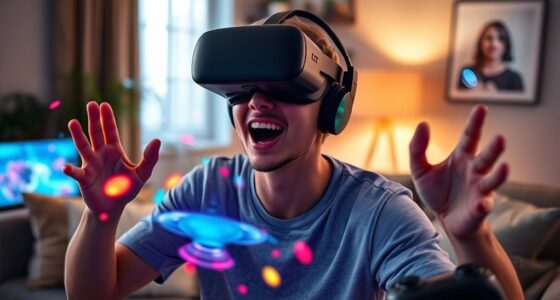Wearable health devices give you useful insights into your sleep and activity patterns, but their metrics aren’t always perfectly accurate. Sensors like accelerometers and optical heart rate monitors can be affected by movement, device fit, and environmental factors, which may lead to slight inaccuracies. While they excel at tracking long-term trends and encouraging healthier habits, they shouldn’t replace medical advice. If you want to understand how these devices truly perform and what influences their accuracy, keep exploring further.
Key Takeaways
- Wearables accurately track sleep and heart rate during rest but may struggle during high activity or irregular sleep.
- Proper device fit and regular syncing enhance the accuracy of fitness metrics.
- Environmental factors and individual differences can affect sensor precision, especially during vigorous exercise.
- Wearables provide general health trend insights, not precise medical measurements.
- Data should be used as motivational tools and complemented with medical advice for health decisions.
Have you ever wondered how wearable health technology is transforming the way we monitor and manage our well-being? Today’s devices do more than just tell time; they track sleep patterns, monitor your heart rate, and provide insights into your overall health. But how accurate are these fitness metrics? That’s the question many people ask as they rely more on these gadgets to guide their health choices.
Let’s start with sleep tracking. Wearable devices use accelerometers and sometimes heart rate sensors to determine when you’re asleep, awake, or in different sleep stages. While these features are impressive, their accuracy isn’t perfect. Many devices can distinguish between sleep and wakefulness fairly well, but differentiating between light, deep, or REM sleep can be more challenging. If you’re deeply concerned about your sleep quality, it’s worth noting that some data might be slightly off, especially if you toss and turn or sleep irregularly. Nonetheless, sleep tracking provides valuable trends over time, helping you identify patterns and make adjustments to improve your rest.
Sleep tracking offers valuable insights but may be slightly off if your sleep is irregular or restless.
Heart rate accuracy is another critical aspect of wearable health tech. Many devices use optical sensors that shine light into your skin to measure blood flow, translating this into your heart rate. For most people, these sensors offer a reliable estimate during rest and moderate activity. However, accuracy can dip during high-intensity workouts or if you’re moving a lot. Factors like skin tone, wrist hair, and device fit also influence how precise the readings are. If you’re using your fitness tracker to monitor your heart rate for medical reasons, keep in mind that these devices are generally not substitute for medical-grade equipment. Still, for everyday activity tracking and general wellness insights, they’re usually quite sufficient. Additionally, understanding the filtration technologies used in some advanced devices can further enhance the accuracy of health monitoring by reducing environmental interference.
The key to getting the most accurate data is wearing your device correctly and being aware of its limitations. For example, ensuring a snug fit can improve heart rate measurement, while syncing your device regularly can help maintain data accuracy. Remember, these metrics are best used as guidelines rather than exact measures. They give you a broad picture of your health trends, motivating you to stay active, get better sleep, and manage stress.
Frequently Asked Questions
How Do Wearable Devices Detect Irregular Heart Rhythms?
You might wonder how wearable devices detect irregular heart rhythms. They use sensors to monitor your heart rhythm detection, often through optical or electrical signals. Many devices incorporate ECG accuracy features, capturing electrical activity similar to medical ECGs. This helps identify irregular heartbeats like AFib. While not as precise as clinical tools, advancements improve their reliability, making these devices useful for early detection and ongoing monitoring of heart rhythm issues.
Can Wearable Health Tech Accurately Measure Hydration Levels?
You might wonder if wearable health tech can accurately measure hydration levels. While some devices attempt hydration measurement through sweat analysis, their accuracy varies. Sweat sensors analyze electrolyte levels to estimate hydration, but factors like skin type and sweat rate impact results. So, while wearable tech offers useful insights, it shouldn’t replace clinical assessments for precise hydration status. Use these tools as a helpful guide, not a definitive measure.
Do Different Brands Provide Comparable Fitness Metrics?
Did you know over 80% of users expect consistent results from their fitness devices? When comparing brands, you’ll find that brand consistency varies, affecting data reliability. Some brands excel in providing accurate, comparable metrics, while others may give inconsistent results. So, if you want dependable data to track your progress, choose brands known for their consistency and accuracy, ensuring your fitness journey stays on the right track.
How Often Should I Calibrate My Wearable Device?
You should calibrate your wearable device regularly to guarantee peak device accuracy. Calibration frequency depends on your device and usage, but generally, doing it every few weeks or after firmware updates helps maintain accuracy. If you notice inconsistent readings or tracking errors, calibrate more often. Staying proactive with calibration keeps your fitness metrics reliable, so you can trust the data for your health goals.
Are Wearable Health Devices Safe for Long-Term Use?
You might wonder if wearable health devices are safe for long-term use. Generally, they’re designed with device durability and battery life in mind, making them safe for extended wear. However, you should monitor for skin irritation or discomfort from prolonged contact. Regularly update the device’s software and follow manufacturer guidelines to guarantee safety. Overall, when used properly, these devices are safe and can support your health goals over time.
Conclusion
Think of wearable health tech as your personal lighthouse—guiding you through the fog of health data. While these devices offer valuable insights, they aren’t perfect compasses. Use them as helpful guides, but don’t rely solely on their readings. Combine their metrics with your own awareness and professional advice. Like a lighthouse, they illuminate the way, but ultimately, your health journey depends on your awareness and informed decisions.









